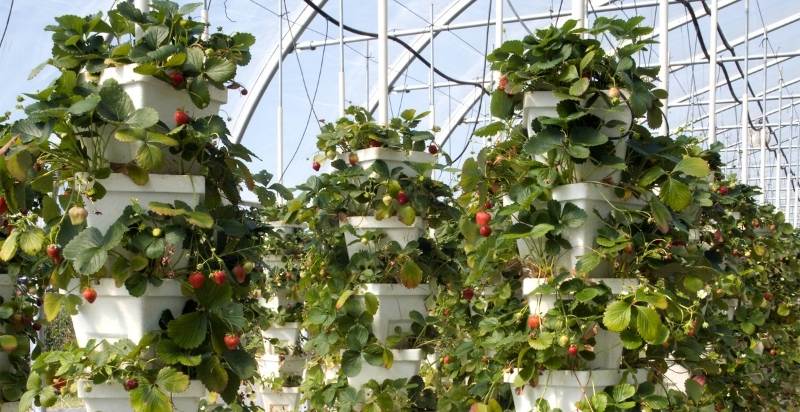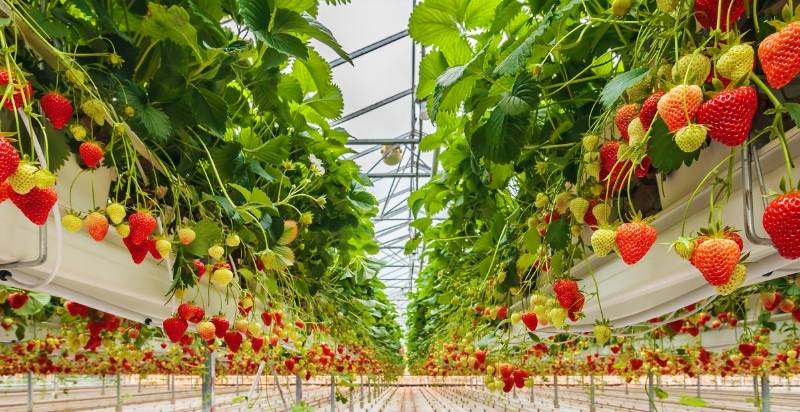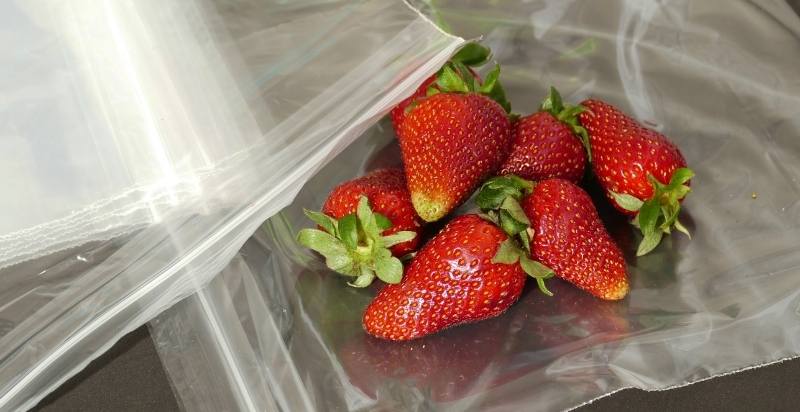Strawberries are a delicious and versatile fruit that can be enjoyed in several ways. They can be eaten fresh, used in jams or pies, or dried and added to cereal or trail mix. No matter how you like to eat them, hydroponic strawberries are a healthy treat packed with vitamins, minerals, and antioxidants.
While most think strawberries are red, wide varieties can be white, yellow, or black. The taste of the different varieties can also vary, with some being sweet and others being more tart.
No matter what type of strawberry you prefer, they all have a similar thing: they’re fun to grow! In this article, we’ll show you how to grow strawberries hydroponically so you can enjoy them all year round.
What are Hydroponic Strawberries?
Hydroponic strawberries are strawberries that are grown using hydroponics, which is a method of growing plants without soil. The plants are grown in a water-based solution containing all the nutrients they need to grow.
Strawberries Hydroponically can be grown indoors or outdoors and often yield larger and sweeter fruits than those grown in traditional soil-based methods. This method of growing strawberries has several benefits, including:
- Reduced Pest Pressure: When strawberries are fully grown in soil, they are susceptible to pests and diseases that can damage the plants or make the fruit unsafe to eat. By growing hydroponically, the risk of pests and diseases is greatly reduced.
- Increased Yields: Hydroponic systems often produce higher yields than traditional soil-based systems. This is because the plants have access to a constant supply of nutrients and water, which they can’t get when grown in soil.
- Space Savings: Hydroponic systems take up less space than traditional farming methods, and this is because the plants are grown vertically rather than horizontally. This makes hydroponic strawberry production perfect for small spaces like apartments or balconies.

Types of Hydroponic Systems:
The type of hydroponic system you use will largely depend on the size of your operation and the amount of space you have available. The most common types of hydroponic systems are:
- Deep Water Culture: Deep water culture systems are considered one of the simplest types of hydroponic systems. The plants are grown in a container of nutrient-rich water, and an air pump is used to oxygenate the water, which is essential for the health of the plants.
- Nutrient Film Technique: Nutrient film technique (NFT) systems are similar to deep water culture systems, but the plants are grown in a shallow stream of nutrient-rich water. A pump is used to circulate the water, which gives the roots of the plant access to oxygen.
- Drip Irrigation: Drip irrigation systems are a type of hydroponic system that utilizes a timer and a network of tubes to deliver water and nutrients to the plants on a schedule. This type of system is perfect for large operations or those who want to automate their strawberry production.
What You Will Need:
To get started growing strawberries hydroponically, you will need the following:
- A container or system in which to grow your strawberries. This can be a simple bucket or tray with holes drilled in the bottom for drainage or a more complex recirculating system.
- Grow media. This can be anything from perlite and vermiculite to coco coir or clay pellets.
- A submersible pump to circulate the nutrient solution.
- An air stone to aerate the solution and prevent stagnation.
- A timer to automate the pump cycle.
- pH test kit
- Nutrient solution formulated for hydroponic strawberry production.
Equipment
As with any type of gardening, a certain amount of equipment is necessary for success. The good news is that you can find your needs at your local garden center or online. For a basic hydroponic strawberry setup, you will need the following:
- A container or system in which to grow your strawberries. This can be a simple bucket or tray with holes drilled in the bottom for drainage or a more complex recirculating system.
- Grow media can be anything from perlite and vermiculite to coco coir or clay pellets.
- A submersible pump to circulate the nutrient solution.
- An air stone to aerate the solution and prevent stagnation.
- A timer to automate the pump cycle.
Nutrient Solution
The nutrient solution is perhaps the most important part of your hydroponic strawberry setup. Strawberries are heavy feeders and require a well-balanced nutrient solution to produce healthy fruit.
A good starting point is a commercially available strawberry fertilizer, but you may need to adjust the pH and nutrient levels to meet the specific needs of your plants. It is a good idea to test the pH and nutrients of your solution every week and make adjustments as needed.
Grow Media
Many different types of growing media can be used for hydroponic strawberry production. The most important thing to consider is that the media must be well-aerated and have good drainage. Some common media types include perlite, vermiculite, coco coir, and clay pellets.
How to Grow Hydroponic Strawberries?
Now that you know what hydroponic strawberries are and some of the benefits of growing them, it’s time to learn how to do it! Growing strawberries hydroponically is quite simple and only requires a few supplies.
Here’s what you’ll need to get started:
- A hydroponic system: There are several types of hydroponic systems, so you’ll need to choose the one that’s right for you. An NFT (nutrient film technique) system is the most common for growing strawberries. These systems can be bought online or at your local garden center.
- Strawberry plants: You can buy them at your local nursery or order them online. Be sure to choose a variety known to do well in hydroponic systems, such as ‘Alpine,’ ‘Seascape,’ or ‘Ozark Beauty.
- A grow light: Strawberries need at least 8 hours of sunlight per day, so you’ll need to provide a grow light if your strawberries are going to be grown indoors.
- Nutrients: Hydroponic systems require nutrients to help the plants grow, and these can be bought at your local garden center or online. Be sure to choose a nutrient solution specifically designed for hydroponic systems.
- pH Tester: It’s important to maintain the pH of your hydroponic system within the ideal range for strawberry plants, which is between 6.0 and 7.0. A pH tester will allow you to test the pH of your system and make adjustments as needed.

Once you have all your supplies, you’re ready to start growing! Here’s a step-by-step guide on how to do it:
- Choose a location for your system: The location you choose for your system should have access to natural light or be able to accommodate a grow light. It should also be large enough to accommodate your system and the strawberry plants.
- Assemble your system: Follow the instructions that come with your system to assemble it. Once it’s assembled, fill the reservoir with water and nutrients.
- Plant your strawberries: Carefully remove the strawberry plants from their pots and plant them in the growing medium of your choice. Be sure to space the plants evenly, so they have room to grow.
- Provide support for the plants: Some types of hydroponic systems, such as NFT systems, don’t provide support for the plants. If this is the case with your system, you’ll need to support the plants yourself. This can be done by tying the plants to a trellis or bamboo stake.
- Monitor the system: Once your strawberries are planted, it’s important to monitor them closely. Be sure to check the water level in the reservoir and add more as needed. You should also check the pH of the water and adjust it as necessary. Additionally, you’ll need to fertilize the plants every few weeks using a nutrient solution designed for hydroponic systems.
Following these simple steps, you can grow delicious hydroponic strawberries right in your home!
Tips for Growing Strawberries Hydroponically:
Here are a few tips to help you grow the best hydroponic strawberries possible:
- Be sure to choose a variety of strawberries that are known to do well in hydroponic systems, such as ‘Alpine,’ ‘Seascape,’ or ‘Ozark Beauty.
- Provide the plants with at least 8 hours of sunlight per day, either from natural light or a grow light.
- Check the water level in the reservoir regularly and add more as needed. Additionally, be sure to check the pH of the water and adjust it as necessary.
- Fertilize the plants every few weeks using a nutrient solution designed for hydroponic systems.
By following these tips, you can grow delicious hydroponic strawberries that are healthy and bountiful!
How To Care For Your Hydroponic Strawberries Plants?
Once you have planted your hydroponic strawberries plants, there are a few things you need to do to ensure they thrive. These include:
- Monitor the pH of your system: It’s important to monitor the pH of your hydroponic system and make adjustments as needed. The ideal range for strawberry plants is between 6.0 and 7.0.
- Check the nutrient levels: You should also regularly check the nutrient levels in your system and make adjustments as needed. If the levels are too low, you can add more nutrients to the system. If the levels are too high, you may need to flush the system with water.
- Keep an eye on the water level: It’s also important to keep an eye on the water level in your system. If it gets too low, you will need to add more water.
- Prune the plants: Strawberry plants should be pruned regularly to encourage fruit production. You can remove any flowers that form and any leaves that are yellow or brown.
- Harvest the fruit: Once the strawberries are ripe, you can harvest them and enjoy them!

Ways to Prevent Strawberries Hydroponically From Pests & Diseases:
One way to prevent pests and diseases in hydroponic strawberries is to use an integrated pest management system. This system uses physical, chemical, and biological controls to manage pests and diseases. Physical controls include traps, barriers, and soil solarization, and chemical controls include insecticides, herbicides, and fungicides. Biological controls include beneficial predators, parasites, and pathogens.
Another way to prevent pests and diseases in hydroponic strawberries is to practice good sanitation. This means keeping the growing area clean and free of debris, weeds, and other sources of pests and diseases. Good ventilation and drainage are also important for preventing problems. Regular scouting for pest and disease problems is also important so that problems can be caught early and treated before they become serious.
How to Store Grown Strawberries Hydroponically?
You can store your grown strawberries hydroponically in a few different ways.
- One way is to store them in the fridge. This is probably the most common way to store strawberries, and it will help keep them fresh for a longer period.
- Another way is to freeze them. This is a great option if you want to enjoy your strawberries all year round. Simply wash and slice your strawberries and then place them in freezer bags.
Another option is to dehydrate them. This is a great way to preserve your hydroponic strawberries and enjoy them later. To dehydrate your strawberries, simply slice them thin and lay them out on a dehydrator tray. Set your dehydrator to the lowest setting and let it run until the strawberries are dried. Depending on how thin you slice them, this can take anywhere from a few hours to a day. Once they are dried, you can store them in an airtight container and enjoy them for months.

Conclusion:
Hydroponic strawberries are a delicious and healthy way to get your daily dose of fruit! Following this guide, you can easily grow your hydroponic strawberries at home. Just be sure to choose the right variety of strawberries, provide the plants with enough light, and monitor the system closely. With a little care, you can enjoy fresh, delicious strawberries all year round!
- Everything You Wanted to Know About Red Tamarillos - June 2, 2025
- A Guide to Tulips: Everything You Need to Know & More… - June 2, 2025
- Guanabana: Description, Flavor, Benefits, And Uses - May 27, 2025

5 thoughts on “How to Grow Strawberries Hydroponically”
Comments are closed.